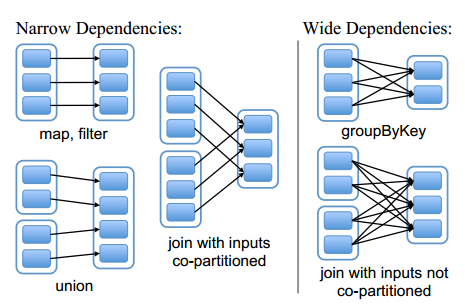Spark RDD源码解析 - RDD依赖关系 Supporting tagline
RDD依赖关系
RDD作为Spark计算模型的核心,被设计成包含以下几种信息的实体:
- A list of partitions
- A function for computing each split
- A list of dependencies on other RDDs
- Optionally, a Partitioner for key-value RDDs (e.g. to say that the RDD is hash-partitioned)
- Optionally, a list of preferred locations to compute each split on (e.g. block locations for an HDFS file)
其中的依赖关系指该RDD的每个分区计算时依赖哪些父RDD的分区,这些信息对于计算任务的调度、容错都非常重要。而根据不同的依赖关系,Spark将其划分为两种类型:窄依赖(narrow dependencies),父RDD的分区最多被一个子RDD的分区依赖;宽依赖(wide dependencies),子RDD的分区依赖于多个父RDD分区。进行依赖关系区分的意义在于:①窄依赖允许在一个集群结点上流水执行所有的计算,而宽依赖则需要首先计算好所有的父RDD数据,然后再在结点之间进行Shuffle操作;②在结点失效后进行恢复时,窄依赖会更加高效,只需要计算丢失的父分区即可,并且不同分区可以在多个结点上并行计算,而一个宽依赖的分区丢失时可能会导致整个过程的重新计算。

在实现上,RDD对象的内部有一个Depedency对象的列表,而每个Depedency对象内部会存储一个RDD对象,对应一个父RDD。通过遍历RDD内部的Dependency列表即可获取该RDD所有依赖的父RDD。
/**
* :: DeveloperApi ::
* Base class for dependencies.
*/
@DeveloperApi
abstract class Dependency[T] extends Serializable {
def rdd: RDD[T]
}
RDD抽象类提供dependencies和partitions接口供开发者调用获取RDD对象的依赖及分区。同时这两个外部接口会调用内部接口getDependencies和getPartitions,RDD的子类需要实现这两个内部接口。
abstract class RDD[T: ClassTag](
@transient private var _sc: SparkContext,
@transient private var deps: Seq[Dependency[_]]
) extends Serializable with Logging {
...
// Our dependencies and partitions will be gotten by calling subclass's methods
// below, and will be overwritten when we're checkpointed
private var dependencies_ : Seq[Dependency[_]] = null
@transient private var partitions_ : Array[Partition] = null
...
/**
* Implemented by subclasses to return the set of partitions in this RDD. This
* method will only be called once, so it is safe to implement a time-consuming
* computation in it.
*/
protected def getPartitions: Array[Partition]
/**
* Implemented by subclasses to return how this RDD depends on parent RDDs. This
* method will only be called once, so it is safe to implement a time-consuming
* computation in it.
*/
protected def getDependencies: Seq[Dependency[_]] = deps
...
/**
* Get the list of dependencies of this RDD, taking into account whether the
* RDD is checkpointed or not.
*/
final def dependencies: Seq[Dependency[_]] = {
checkpointRDD.map(r => List(new OneToOneDependency(r))).getOrElse {
if (dependencies_ == null) {
dependencies_ = getDependencies
}
dependencies_
}
}
/**
* Get the array of partitions of this RDD, taking into account whether the
* RDD is checkpointed or not.
*/
final def partitions: Array[Partition] = {
checkpointRDD.map(_.partitions).getOrElse {
if (partitions_ == null) {
partitions_ = getPartitions
}
partitions_
}
}
}
依赖类
Spark中用Dependency类来表示在经过转换操作后,父RDD与子RDD之间的联系(依赖关系)。如上所述,Dependency是一个只包含一个def rdd: RDD[T]方法的抽象类。它有如下几种派生类:
- NarrowDependency
- OneToOneDependency
- PruneDependency
- RangeDependency
- ShuffleDependency
ShuffleDependency
ShuffleDependency是一种会导致shuffle map stage(是一个在执行DAG时会执行shuffle操作的中间阶段,是后续阶段的输入)的依赖关系。
一个ShuffleDependency应该属于一个key-value对RDD(其rdd成员的类型为RDD[Product2[K, V]])。而每一个ShuffleDependency对象都有一个shuffleId。
ShuffleDependency使用partitiner分割shuffle的输出。使用ShuffleManager来进行注册,以及ContextCleaner来注册自己进行清洗。每一个ShuffleDependency对象都使用其shuffleId和RDD的分区数目向MapOutputTrackerMaster注册。
会使用到ShuffleDependency的场景包括:
- 当多个RDD的
partitioner不同时,生成CoGroupedRDD和SubtractedRDD - 通过shuffle操作生成的
ShuffledRDD或ShuffledRowRDD
可能用到也可能用不到上述RDD,而会进行shuffle的RDD操作有:
- coalesce
- repartition
- cogroup
- intersection
- subtractByKey
- substract
- sortByKey
- sortBy
- repartitionAndSortWithinPartitions
- combineByKeyWithClassTag
- combineByKey
- aggregateByKey
- foldByKey
- reduceByKey
- countApproxDistinctByKey
- groupByKey
- partitionBy
内部RDD类
Spark内部实现的RDD派生类有ParallelCollectionRDD, CoGroupedRDD, HadoopRDD, MapPartitionsRDD, CoalescedRDD, ShuffledRDD, PairRDD, UnionRDD等。
ParallelCollectionRDD
ParallelCollectionRDD是一个拥有numSlices个分区,以及可选的locationPrefs选项的元素集合,这些元素分散存储在numSlices个分区中。一个ParallelCollectionRDD对象通常是SparkContext.parallelize和SparkContext.makeRDD方法的运行结果。因此,我们可以将其看作一个应用中最初的RDD对象。
MapPartitionsRDD
MapPartitionsRDD是在父RDD的每个分区上执行给定函数f后得到的结果类型,对应其compute函数为对给定Partition调用f,进行计算。默认情况下,MapPartitionsRDD不会保留原始RDD的分区,当构造函数的最后一个参数preservesPartitioning是true的时候,保留原始分区。
/**
* An RDD that applies the provided function to every partition of the parent RDD.
*/
private[spark] class MapPartitionsRDD[U: ClassTag, T: ClassTag](
var prev: RDD[T],
f: (TaskContext, Int, Iterator[T]) => Iterator[U], // (TaskContext, partition index, iterator)
preservesPartitioning: Boolean = false)
extends RDD[U](prev) {
override val partitioner = if (preservesPartitioning) firstParent[T].partitioner else None
override def getPartitions: Array[Partition] = firstParent[T].partitions
override def compute(split: Partition, context: TaskContext): Iterator[U] =
f(context, split.index, firstParent[T].iterator(split, context))
override def clearDependencies() {
super.clearDependencies()
prev = null
}
}
结果是MapPartitionsRDD的转换操作有:map, flatMap, filter, glom, mapPartitions, mapPartitionsWithIndex, PairRDDFunctions.mapValues, PairRDDFunctions.flatMapValues。
我们选择观察map和filter函数的实现,分析MapPartitionsRDD的生成过程。在RDD类中有map及filter函数的实现,其代码如下。可见,其生成过程为:创建一个MapPartitionsRDD对象,并将函数f作为参数传入,并将f变形为对一个分区的元素迭代调用f(map地调用或filter地调用), 在真正(lazy compute)计算时,调用compute函数,对每个分区执行f计算。
/**
* Return a new RDD by applying a function to all elements of this RDD.
*/
def map[U: ClassTag](f: T => U): RDD[U] = withScope {
val cleanF = sc.clean(f)
new MapPartitionsRDD[U, T](this, (context, pid, iter) => iter.map(cleanF))
}
...
/**
* Return a new RDD containing only the elements that satisfy a predicate.
*/
def filter(f: T => Boolean): RDD[T] = withScope {
val cleanF = sc.clean(f)
new MapPartitionsRDD[T, T](
this,
(context, pid, iter) => iter.filter(cleanF),
preservesPartitioning = true)
}
blog comments powered by Disqus